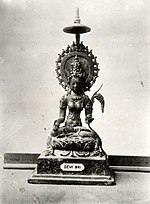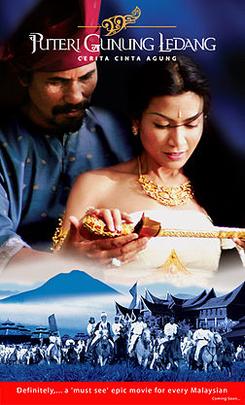
Puteri Gunung Ledang is a 2004 Malaysian Malay-language epic fantasy period film directed by Saw Teong Hin. The film is based on the Malay legend of the Gunung Ledang princess, who is said to have lived on top of Gunung Ledang, and a Malaccan sultan's effort to court her. The film stars Tiara Jacquelina, M. Nasir and Adlin Aman Ramlie.

A bomoh is a Malay shaman and traditional medicine practitioner. The term is used mainly in Malaysia and parts of Sumatra, whereas most Indonesians use the word dukun. It is often mistranslated into English as medicine man or witch doctor. In colloquial usage, the term bomoh is often interchangeable with another type of shaman or dukun, the pawang, but they generally serve different functions. The bomoh is primarily a healer, herbalist, geomancer, and sorcerer. The pawang on the other hand usually specialises in rituals involving weather, nature, animals, and a good harvest. Their roles do overlap however, and both claim to act as intermediaries for the spirits and gods.

Hantu is the Malay and Indonesian word for spirit or ghost. In modern usage it generally means spirits of the dead but has also come to refer to any legendary invisible being, such as demons. In its traditional context the term also referred to animistic nature spirits or ancestral souls. The word is derived from Proto-Malayo-Polynesian *qanitu and Proto-Austronesian *qaNiCu. Cognates in other Austronesian languages include the Micronesian aniti, Lio language nitu, Yami anito, Taivoan alid, Seediq and Atayal utux, Bunun hanitu or hanidu, Polynesian aitu or atua, and Tsou hicu among the Formosan languages. In terms of concept and place in traditional folklore, it is most similar to the Filipino anito.

There are many Malay ghost myths, remnants of old animist beliefs that have been shaped by Hindu-Buddhist cosmology and later Muslim influences, in the modern states of Brunei, Indonesia, Malaysia, and Singapore and among the Malay diaspora in neighbouring Southeast Asian countries. The general word for ghost is hantu, of which there exist a wide variety. Some ghost concepts such as the female vampires pontianak and penanggal are shared throughout the region. While traditional belief does not consider all ghosts as necessarily evil, Malaysian popular culture tends to categorise them all as types of evil djinn.
Pelesit is a type of familiar spirit in Malay folklore. It is generally a cricket, or occasionally a grasshopper. The term literally means "buzzer" from the root word lesit meaning to buzz or whizz, as an insect does. They are also called Palasik.
The polong is a type of familiar spirit in Malay folklore. It has the appearance of a miniature woman, the size of the first joint of the finger.
The Hantu Raya is a type of familiar spirit in Malay folklore that acts as a double for black magic practitioners. Roughly meaning "great ghost", it is supposed to bestow great power onto its master. Its true form according to folktale is humanoid form with black hairy body except the facial area, rough grey skin, long sharp teeth and with red eyes.

Folklore of Indonesia is known in Indonesian as dongeng, cerita rakyat or folklor, refer to any folklore found in Indonesia. Its origins are probably an oral culture, with a range of stories of heroes associated with wayang and other forms of theatre, transmitted outside of a written culture. Folklore in Indonesia are closely connected with mythology.

Indonesian literature is a term grouping various genres of South-East Asian literature.

The lesser mouse-deer, lesser Malay chevrotain, or kanchil is a species of even-toed ungulate in the family Tragulidae.
Anwar Hadi Ramli is a playwright and actor who has appeared in several TV films and theatre productions since 2000. He appeared in the 2008 Kallang Roar the Movie as Gelek King Dollah Kassim in Singapore national football team of the 1970s. He is currently working in theatre. In 2017, his play, The (Assumed) Vicious Cycle of a (Melayu) Youth, won the Best Theatre Script at the Anugerah Persuratan by the Malay Language Council of Singapore.

Malaysian literature is the collection of literary works produced in the Malay peninsula until 1963 and in Malaysia thereafter. Malaysian literature is typically written in any of the country's four main languages: Malay, English, Chinese and Tamil. It portrays various aspects of Malaysian life and comprises an important part of the culture of Malaysia.
Khadijah Hashim is a Malaysian writer, teacher and journalist. She has worked as a teacher and also as a journalist with local newspapers Utusan Melayu (1974–1976) and Berita Harian (1976–1985). She is better known as a novelist, and has produced 19 novels. She also expanded her creativity in the field of short stories, radio drama scripts, children's books, rhymes and poetry. The children's rhyme book "Sayang Sayang" has been selected to be on Honour List of the International Board on Books for Young People (IBBY) in Basel, Switzerland (2002) and "Semerbak Poetry" in Macau, China (2006). Khadijah continues her interests in writing rhymes, which led to her latest creation of "Putera-puteri Malaysia".

The mythology of Indonesia is very diverse, the Indonesian people consisting of hundreds of ethnic groups, each with their own myths and legends that explain the origin of their people, the tales of their ancestors and the demons or deities in their belief systems. The tendency to syncretize by overlying older traditions with newer foreign ideas has occurred. For example, the older ancestral mythology might be merged with foreign mythology, such as Hindu, Islam, or Christian biblical mythology.
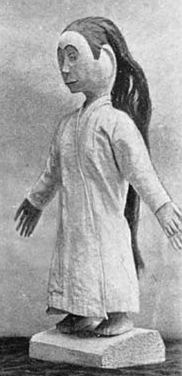
The langsuyar, also lang suir or langsuir, is a female revenant in Malay and other mythologies in the Malay archipelago. The word is derived from the Malay word for eagle.
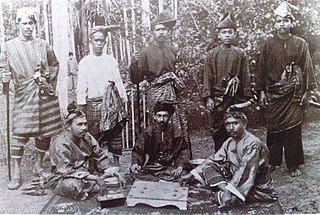
Pahang Malays are a sub-group of Malay people native to the state of Pahang, in the east coast of Peninsular Malaysia. With population of approximately 1.08 million people, they constitutes 70% of Pahang state's population, making them the dominant ethnic group in the state. Their language, Pahang Malay is one of many Malayan languages spoken in the region that belong to the Malayo-Polynesian group of Austronesian family.
Pada Zaman Dahulu, is a Malaysian animated series first broadcast in 2011 on TV Alhijrah and later on Astro Ceria. The series revolves around Ara and Aris and their grandfather Aki, who tells his grandchildren tales that feature kancil, a mouse-deer popular in Malaysian folklore, and various other animal characters such as crocodile, buffalo and monkey. Produced by Les' Copaque Production, Pada Zamam Dahulu is part of the Upin & Ipin franchise and the first series consists of 12 episodes of 6–7 minutes each, with each story covering 3 episodes.
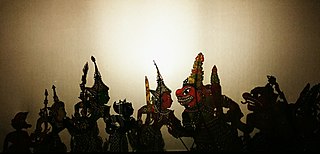
Malaysian folklore is the folk culture of Malaysia and other indigenous people of the Malay archipelago as expressed in its oral traditions, written manuscripts and local wisdoms. Malaysian folklores were traditionally transmitted orally in the absence of writing systems. Oral tradition thrived among the Malays, but continues to survive among Orang Asli and numerous Bornean ethnic groups in Sarawak and Sabah. Nevertheless, Malaysian folklores are closely connected with classical Malay folklore of the region. Even though, Malay folklore tends to have a regional background, with the passing of time, and through the influence of the modern media, large parts of regional Malay folklore have become interwoven with the wider popular Malaysian folklore.

